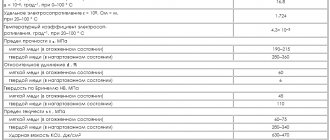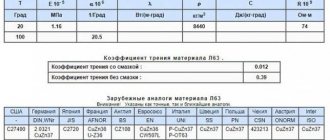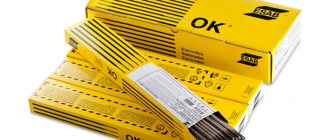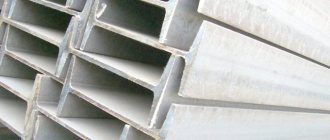Technical copper
In the annealed state, it is quite plastic, but has relatively low strength. The chemical composition of technical grades of copper is determined by GOST 859–41. Technical grades are used in the smelting of copper alloys as a charge material. Technical grade M0 is used in the manufacture of high-purity alloys and current conductors. M1 in the manufacture of semi-finished products obtained by rolling, in the production of high-quality bronzes that do not contain tin. M2 is a technical grade used for the production of bronzes for the production of high-quality semi-finished products that are processed under pressure. The MZ technical grade is in demand for semi-finished products that are produced by rolling, the production of standard quality bronzes and other casting alloys, as well as non-critical electrical contacts (like the M2 alloy). Technical grade M4 is used in the smelting of cast bronzes.
Application
The material is used for the manufacture of cryogenic equipment elements, as well as cold-rolled, pressed or drawn high-quality products:
- anodes and various shaped casting parts;
- pipes, rods, wire of various sections and diameters;
- cold rolled sheets.
In addition, the material of this brand is widely used for the production of washers - sealing elements in brake and air systems, hydraulic mechanisms, designed for high loads regarding temperature, pressure, vibration. In particular, these are engine power systems, starting thermostat heaters, fine fuel filters, and fuel pumps.
Due to its excellent electrical conductivity, M2 grade copper is widely used in the manufacture of cable products. M2 copper is a raw material for the production of copper-nickel alloys, brass and bronze.
To protect against corrosion, the surfaces of ferrous metal products are coated with molten copper.
You can buy M2 copper products at affordable prices at. You can place an order by calling: +7(812) 743-99-34, or by sending a request through the website. We will deliver the goods to your address in St. Petersburg and other regions of Russia.
Impurities in copper alloys
Impurities contained in copper (and, naturally, interacting with it) are divided into three groups.
Forming solid solutions with copper
Such impurities include aluminum, antimony, nickel, iron, tin, zinc, etc. These additives significantly reduce electrical and thermal conductivity. The grades that are primarily used for the production of conductive elements include M0 and M1. If the copper alloy contains antimony, its hot pressure treatment becomes significantly more difficult.
Impurities that do not dissolve in copper
These include lead, bismuth, etc. Although they do not affect the electrical conductivity of the base metal, such impurities make it difficult to process by pressure.
Impurities that form brittle chemical compounds with copper
This group includes sulfur and oxygen, which reduces the electrical conductivity and strength of the base metal. The sulfur content of the copper alloy greatly facilitates its machinability by cutting.
Copper grades and their applications
Marking
In addition to differences in grades, there are different markings of this non-ferrous metal (according to its purity):
The last element of the marking is a letter that indicates the method of copper production (k - cathode, f - deoxidized with phosphorus, b - oxygen-free, p - deoxidized).
accepts various types of copper at our points, as well as at the client’s premises (in case of large volumes of scrap). We will determine the type of metal and, if necessary, send it for additional chemical examination. We work officially, so we provide a full package of documents for supervisory authorities.
Source
Percentage composition
| Percentage composition of material | |||||||||||||
| Copper alloy grades | Fe | Ni | S | Cu | As | Pb | O | Sb | Bi | Sn | P | Zn | Ag |
| M1 | ≤ 0.005 | ≤ 0.0020 | ≤ 0.004 | 99.9 | ≤ 0.0020 | ≤ 0.005 | ≤ 0.05 | ≤ 0.002 | ≤ 0.001 | ≤ 0.002 | ≤ 0.004 | ≤ 0.003 | |
| M 1р | ≤ 0.005 | ≤ 0.0020 | ≤ 0.005 | 99.9 | ≤ 0.0020 | ≤ 0.005 | ≤ 0.01 | ≤ 0.002 | ≤ 0.001 | ≤ 0.002 | from 0.002 to 0.012 | ≤ 0.005 | |
| M 2 | ≤ 0.05 | ≤ 0.2 | ≤ 0.01 | 99.7 | ≤ 0.01 | ≤ 0.01 | ≤ 0.07 | ≤ 0.005 | ≤ 0.0020 | ≤ 0.05 | |||
| M 2p | ≤ 0.05 | ≤ 0.2 | ≤ 0.01 | 99.7 | ≤ 0.01 | ≤ 0.01 | ≤ 0.01 | ≤ 0.005 | ≤ 0.0020 | ≤ 0.05 | |||
| M 3 | ≤ 0.05 | ≤ 0.2 | ≤ 0.01 | 99.5 | ≤ 0.01 | ≤ 0.050 | ≤ 0.08 | ≤ 0.050 | ≤ 0.003 | ≤ 0.05 | |||
| M 3р | ≤ 0.05 | ≤ 0.2 | ≤ 0.01 | 99.5 | ≤ 0.05 | ≤ 0.03 | ≤ 0.01 | ≤ 0.05 | ≤ 0.003 | ≤ 0.05 | from 0.005 to 0.06 |
Use of copper in medicine
The use of copper in the medical industry can be found quite often. According to the norms of traditional medicine, copper is an extremely important element of human life. In our body, copper is present in a volume of 2 * 10-4% of a person’s total weight. Every day we consume approximately 60 mg of copper with food, but only 2 mg is absorbed, but this is the amount that is the daily norm for an adult. Copper is extremely important in the process of hemoglobin biosynthesis, as well as in maintaining sugar, cholesterol and uric acid levels. In order for the cardiovascular system, brain, and digestive tract to function as expected, copper is needed. With a chronic lack of copper in the human body, the following diseases develop:
- anemia;
- osteoporosis;
- glaucoma;
- psoriasis;
- the heart muscle atrophies;
- a person gets tired quickly and loses weight;
- Cholesterol accumulates in the body.
The richest foods containing copper are:
- Champignon;
- potato;
- Cod liver;
- whole grain;
- oysters and cuttlefish.
Pure copper
Grade M0 contains 99.95% Cu and no more than 0.05% impurities. According to special technical conditions, several grades of vacuum copper and especially oxygen-free pure copper are produced, which is used in the electric vacuum industry. Strips, tapes, rods, and pipes are produced from oxygen-free copper of series A and B. Tapes and rods are made from vacuum pure copper. Rods are produced from pure copper, which is deoxidized with manganese. All these semi-finished products are used in the electrovacuum industry. Oxygen-free pure copper is characterized by a low (-100°C) recrystallization temperature.
The price for copper scrap is higher with non-cash payment
Cash payments for metal cause a lot of trouble for suppliers. It is easier to buy copper scrap by bank transfer.
Nowadays, many large and honest producers of copper scrap suggest that regular scrap dealers should have a special bank card. They transfer money to this card for purchased copper scrap. There are special applications for smartphones that allow you to immediately check the receipt of money.
Basic properties of copper
Physical properties
In air, copper acquires a bright yellowish-red hue due to the formation of an oxide film. Thin plates have a greenish-blue color when examined through them. In its pure form, copper is quite soft, malleable and easily rolled and drawn. Impurities can increase its hardness.
This is interesting: Inch threads - dimensions, table, GOST with diameters and pitch, designations in mm
The high electrical conductivity of copper can be called the main property that determines its predominant use. Copper also has very high thermal conductivity. Impurities such as iron, phosphorus, tin, antimony and arsenic affect the basic properties and reduce electrical and thermal conductivity. According to these indicators, copper is second only to silver.
Copper has high densities, melting points and boiling points. An important property is also good resistance to corrosion. For example, at high humidity, iron oxidizes much faster.
Copper lends itself well to processing: it is rolled into copper sheets and copper rods, and drawn into copper wire with a thickness brought to thousandths of a millimeter. This metal is diamagnetic, that is, it is magnetized against the direction of the external magnetic field.
Chemical properties
Copper is a relatively low-active metal. Under normal conditions in dry air, its oxidation does not occur. It reacts easily with halogens, selenium and sulfur. Acids without oxidizing properties have no effect on copper. There are no chemical reactions with hydrogen, carbon and nitrogen. In humid air, oxidation occurs to form copper (II) carbonate, the top layer of platinum. Copper is amphoteric, meaning it forms cations and anions in the earth's crust. Depending on the conditions, copper compounds exhibit acidic or basic properties.
Features of popular copper alloys
Alloy M1 is manufactured in accordance with GOST 859-2014, is a highly plastic and well-processed metal, and has the highest copper content (99.9%). Additional elements include zinc, nickel, phosphorus, iron, arsenic, oxygen, tin, bismuth (total no more than 0.1%). The electrical resistivity is 0.018 μOhm. The alloy can be of two types - hard (M1t) and soft (M1m), they differ in strength and fluidity. Rolled metal is in demand in the automotive and aircraft industries, in the creation of current conductors, cryogenic equipment, wire and rods.
Alloy M2 has a lower copper ratio in the composition (99.7%). The remaining 0.3% comes from nickel, iron, antimony, oxygen, tin, lead, sulfur, and arsenic. This grade is ductile and does not rust, is excellent in pressure processing and is used for the manufacture of copper-based alloys and refrigeration parts.
Alloy M3 is technical copper; it contains the smallest percentage of metal among those presented (99.5%). The same elements as in M2 are used as alloying components, only in a larger proportion (up to 0.5%), which makes this alloy the most affordable. Optimally suitable for metal products that are sold by rolling methods, as well as cast alloys.
Application
In addition to the preparation of new alloys, this metal is used for the production of shaped castings and semi-finished products - sheets, plates, pipes, wire, rods, etc. They are in demand in the manufacture of cryogenic and climate control equipment, car parts, aircraft and devices for various purposes. Due to its conductivity of heat and electricity, M2 copper serves as an excellent raw material for electrical wiring, and its decorative features allow it to be used in architecture and design.
Fill out the information below and our managers will contact you as soon as possible and also advise you on any questions you may have.
Source
Biological value for humans
Copper belongs to the category of vital elements, and the body of an adult contains about 100 grams of this metal. A reassessment of the toxicity of this substance was carried out in 2003 by the World Health Organization. Studies have found that copper is not a cause of diseases of the digestive tract, and does not provoke the development of Wilson-Konovalov disease (hepatocerebral dystrophy affecting the liver and brain), as previously thought. Scientists have concluded that a lack of copper is more harmful to human health than its excess.
The bactericidal properties of copper have been known for a long time, and recent studies in this area have confirmed the effectiveness of the metal in the prevention of swine flu and infection by Staphylococcus aureus. In experiments, it was found that 99% of pathogenic bacteria die on a copper surface within 2 hours. Therefore, copper and its alloys are widely used for water disinfection. In Europe, door handles, locks, hinges and railings are made from this metal, which are installed in medical institutions and public places.
Methods for obtaining copper
In nature, copper exists in compounds and in the form of nuggets. The compounds are represented by oxides, bicarbonates, sulfur and carbon dioxide complexes, as well as sulfide ores. The most common ores are copper pyrite and copper luster. The copper content in them is 1-2%. 90% of primary copper is mined using the pyrometallurgical method and 10% using the hydrometallurgical method.
1. The pyrometallurgical method includes the following processes: enrichment and roasting, smelting for matte, purging in a converter, electrolytic refining. Copper ores are enriched by flotation and oxidative roasting. The essence of the flotation method is as follows: copper particles suspended in an aqueous medium adhere to the surface of air bubbles and rise to the surface. The method allows you to obtain copper powder concentrate, which contains 10-35% copper.
Copper ores and concentrates with a significant sulfur content are subject to oxidative roasting. When heated in the presence of oxygen, sulfides are oxidized, and the amount of sulfur is reduced by almost half. Poor concentrates containing 8-25% copper are roasted. Rich concentrates containing 25-35% copper are melted without resorting to roasting.
The next stage of the pyrometallurgical method for producing copper is smelting for matte. If lump copper ore with a large amount of sulfur is used as a raw material, then smelting is carried out in shaft furnaces. And for powdered flotation concentrate, reverberatory furnaces are used. Melting occurs at a temperature of 1450 °C.
In horizontal converters with side blowing, the copper matte is blown with compressed air in order for the oxidation of sulfides and ferrum to occur. Next, the resulting oxides are converted into slag, and sulfur into oxide. The converter produces blister copper, which contains 98.4-99.4% copper, iron, sulfur, as well as small amounts of nickel, tin, silver and gold.
This is interesting: Ejector - what is it? The principle of operation of ejector pumps and their design
Blister copper is subject to fire and then electrolytic refining. Impurities are removed with gases and converted into slag. As a result of fire refining, copper is formed with a purity of up to 99.5%. And after electrolytic refining, the purity is 99.95%.
2. The hydrometallurgical method involves leaching copper with a weak solution of sulfuric acid, and then separating copper metal directly from the solution. This method is used for processing low-grade ores and does not allow for the associated extraction of precious metals along with copper.
Copper alloys, their properties, characteristics, grades
The production of copper alloys makes it possible to improve the properties of copper without losing the main advantages of this metal, as well as to obtain additional useful properties.
Copper alloys include: bronze, brass and copper-nickel alloys.
Brass
This is an alloy of copper and zinc. In addition to zinc, it also contains other alloying additives, including tin.
Brasses are corrosion-resistant alloys. They have anti-friction properties to resist vibrations. They have high fluidity rates, which gives products made from them a high degree of resistance to heavy loads. In brass castings, segregation areas are practically not formed, so the products have a uniform structure and density.
Brasses are marked with a set of alphanumeric codes, where the first letter is always L, meaning brass itself. Next comes a digital indicator of the percentage of copper in brass. The remaining letters and numbers indicate the content of alloying elements as a percentage. Brasses use the same letter designations for alloying elements as bronzes.
An example of double brass marking: L85. It stands for “brass with a copper content of up to 85%, the rest is zinc.”
An example of multi-component brass marking: LMtsA57-3-1. It stands for “brass with a copper content of up to 57%, manganese - up to 3%, aluminum - up to 1%, the rest is zinc.”
Bronze
An alloy of copper and tin. However, with the development of technology, bronzes also appeared, in which, instead of tin, aluminum, silicon, beryllium and lead were introduced into the alloy.
Bronze is harder than copper. They have higher strength ratings. They are better suited to metal forming, especially forging.
Marking of bronzes is carried out using alphanumeric codes, where the first letters are Br, meaning bronze itself. Additional letters indicate alloying elements, and numbers after the letters indicate the percentage of such elements in the alloy.
Letter designations of bronze alloying elements:
- A – aluminum,
- B – beryllium,
- F – iron,
- K – silicon,
- Mts – manganese,
- N – nickel,
- O - tin,
- C – lead,
- C – zinc,
- F – phosphorus.
An example of marking tin bronze: BrO10S12N3. It stands for “tin bronze with a tin content of up to 10%, lead – up to 12%, nickel – up to 3%.”
An example of decoding aluminum bronze: BrAZh9-4. It stands for “aluminum bronze with an aluminum content of up to 9% and iron up to 4%.”
Copper-nickel alloys
- Cupronickel is an alloy of copper and nickel. Iron and manganese may be present in the alloy as additives. Special cases of technical alloys based on copper and nickel:
- Nickel silver – additionally contains zinc,
- Constantan – additionally contains manganese.
Cupronickel has high corrosion resistance. It lends itself well to any type of mechanical processing. Non-magnetic. It has a pleasant silver color.
Due to its properties, cupronickel is, first of all, a decorative and applied material. Jewelry and souvenirs are made from it. For decorative purposes it is an excellent substitute for silver.
There are 2 brands of cupronickel available:
- MNZHMts – an alloy of copper with nickel, iron and manganese;
- MH19 is an alloy of copper and nickel.
1 Marking according to GOST - indicators and characteristics
Depending on the amount of additives and alloying elements, in the production of copper alloys with different properties are obtained: anti-friction, high-strength, and highly resistant to chemical changes. The most widespread are alloys with the addition of zinc, aluminum, manganese and magnesium. However, the industry also uses variants with a wide variety of chemical elements.
To determine the specific composition, according to the GOST 859-2001 classification, there is a special table with characteristics and markings. Unlike steel alloys, the abbreviated marking table indicates the minimum permissible percentage of copper content and the percentage of oxygen and phosphorus impurities at the maximum permissible value. For example, M00k, M1k and M2k. The table gives an idea of certain brands.
Most often, cathode copper or copper semi-finished products are used, that is, wire rod, rolled products, ingots and products made of copper alloys. Features and areas of application of the metal, according to the table according to GOST 859-2001, are calculated based on the percentage of various impurities. Different brands may contain from 10 to 50 impurities. Copper is most often classified into two groups:
The classification according to GOST 859-2001 corresponds to the foreign classification according to DIN with the mandatory designation of chemical elements and impurities. For example, grade M00 is CuOFE, M1 is CuOF.







